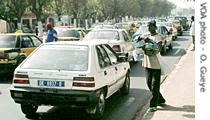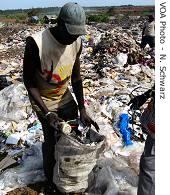2007年VOA标准英语-Dakar Marks 150 Year Anniversary, Struggles to(在线收听)
Dakar
25 May 2007
Friday marks 150 years since French colonists first established a port in what is now the Senegalese capital of Dakar. Originally a small fishing village, Dakar has become the political, economic, and cultural center of the country. But with a population of over two million, the city is facing serious infrastructure problems and is struggling to maintain basic sanitation and transportation for its ever increasing population. For VOA, Selah Hennessy reports from Dakar.

Traffic hawkers in the streets of Dakar, Senegal
In his makeshift studio in a garden in the impoverished Dakar suburb of Pikine, artist Birame Ndiaye is painting a city scene with heavy brown and gray hues.
Ndiaye says his art is inspired by the many decaying walls of Dakar; the deteriorated remnants of grand colonial buildings.
For him, the history of the walls, which are now crumbling and covered with flyers and graffiti, reflect the history and deterioration of Dakar.
He says it is through the walls that he understands the life of the city.
In his studio he is surrounded by dozens of paintings, all in the same heavy colors, depicting gray ghetto scenes and indistinct figures.
He says the figures depict the faceless, anonymous poor who struggle everyday in the ghettos of Dakar.
The population of Dakar is now over two million, having more than doubled in the last three decades.
Ndiaye says that as the population of Dakar has ballooned and the city has rapidly expanded, the poor have been pushed to the outskirts and forgotten.
Ibrahima Aidara, of Oxfam America, says Dakar is struggling to keep pace with the mass influx of people.
"You can see a lot of tension on land. Land is a big issue, because Dakar is a quiet island and it is very small comparatively to the population living within the city," he said.
He adds that Dakar does not have a sufficient infrastructure to provide health care, education, and water and sanitation facilities to the impoverished city suburbs.
"You can see in a lot of suburb areas in Dakar where people are getting, its unbelievable but true, people are getting water from wells, which is to me not acceptable," he said.
The economist Moubarak Lo says Dakar is now entering a new phase of its history, one in which the government is re-emerging and playing an active role in improving the city. He uses as an example the expansion of the corniche, a main road that runs the length of Dakar, along the coast.
"The government wants to promote development of hotels and conference facilities all along the corniche. And you have also extension of the roads, not new roads, but just there used to be say two lines, making them four, building many bridges, and also lighting more the city to make it in the standard of the big metropolises in the world."
 |
| A scavenger at Dakar's dump collects trash to sell |
"You can build a new building, nice building, but if the jobs and other advancements do not follow, you will have a third world in a first world city," he said.
The artist Ndiaye says that though the suburbs of Dakar are marked by poverty, they are also filled with color and creativity, and may bring new life to Dakar.